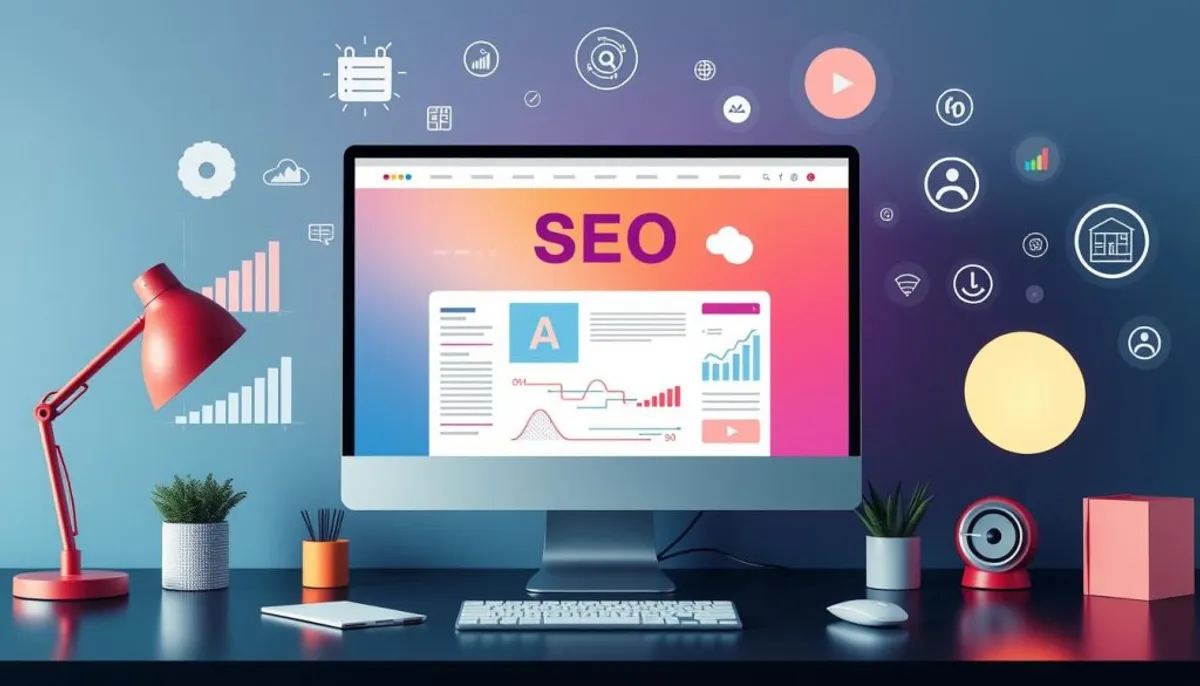Professional website design is crucial for online success in 2024. It creates a positive user experience and builds trust. A well-designed site guides visitors towards action, like making purchases or signing up for newsletters.
Good design makes websites accessible to all users, including those with disabilities. This approach broadens your audience and enhances SEO efforts. It also increases user engagement across your site.

Key Takeaways
- Professional website design is crucial for building a strong online presence and business success.
- Well-designed websites create a positive user experience, enhance brand credibility, and drive desired actions.
- Accessible web design ensures inclusivity and boosts SEO performance.
- Responsive design is essential for providing an optimal user experience across devices.
- Integrating web design and SEO strategies can significantly improve visibility and online performance.
Importance of Professional Website Design
A professional website design is crucial for businesses in today’s digital world. It helps establish a strong online presence and connect with target audiences. Strategic design enhances user experience and builds brand credibility, driving engagement and conversions.
Enhancing User Experience
A well-designed website focuses on user needs and preferences. It creates a smooth and intuitive experience. Every aspect guides visitors toward desired actions effortlessly.
From layout to interactive features, careful crafting improves customer engagement. This fosters a lasting positive impression of the brand.
Building Brand Credibility
Web design is a powerful tool for building brand credibility and trust. An appealing, cohesive website shows professionalism and attention to detail. These qualities are vital for establishing a strong digital presence.
A well-designed site sets brands apart from competitors. It increases user confidence and boosts conversion likelihood.
Investing in good design creates a memorable user experience. It enhances brand credibility and appeal to target audiences. This approach is key to successful web development and digital marketing strategies.
Key Elements of Effective Web Design
Creating a great website requires attention to key design elements. We focus on enhancing user experience. This ensures visitors can easily navigate your site and find information quickly.
User-Friendly Layout
A clear, logical layout is crucial for reducing bounce rates. It encourages users to explore your website further. We design intuitive navigation systems with streamlined information architecture.
Our focus on website usability creates a user-friendly layout. This promotes engagement and builds trust in your brand.
Visually Appealing Graphics
Visual elements shape your website’s aesthetics and appeal. We carefully select high-quality images, icons, and graphics. These reflect your brand’s identity and captivate your target audience.
Our visually appealing graphics complement the website design. This creates a harmonious and pleasing experience for visitors.
Responsive Design
Users access websites from various devices today. A responsive design is essential. We ensure your website adapts to different screen sizes.
This provides optimal mobile optimization and user experience. Our responsive design approach maintains high website usability and reduces bounce rates.
| Design Element | Importance | Key Benefits |
|---|---|---|
| User-Friendly Layout | Enhances navigation and information architecture | Reduces bounce rates, fosters engagement, and builds trust |
| Visually Appealing Graphics | Reflects brand identity and captivates the target audience | Creates a harmonious and aesthetically pleasing experience |
| Responsive Design | Ensures optimal user experience across devices | Maintains high levels of website usability and mobile optimization |
Web Design for Improved Search Engine Optimization
Our web design approach focuses on search engine optimization (SEO). We create websites that are visually appealing and easily discoverable by potential customers. Our designers and SEO specialists collaborate to optimize your website for maximum visibility and ranking.
We develop a robust site structure to enhance crawlability and indexability. This involves careful planning of information architecture, internal linking, and URL structure. Our team ensures search engines can easily navigate and understand your content.
We optimize on-page elements like title tags, meta descriptions, and heading tags. These are strategically incorporated to reflect target keywords and reinforce relevance to search queries. This approach helps improve your website’s performance in search results.
| Key Web Design Elements for SEO | Importance |
|---|---|
| Site Structure and Navigation | Enhances website crawlability and user experience |
| Responsive Design | Ensures your website is mobile-friendly and accessible to a wider audience |
| Optimized Content and Metadata | Improves search engine visibility and relevance |
| Image and Video Optimization | Boosts engagement and contributes to overall SEO performance |
We blend web design and SEO best practices to create high-performing websites. This approach attracts and engages your target audience effectively. As a result, your site drives more qualified traffic and conversions to your business.

Crafting a Seamless User Journey
User experience is key in effective web design. We focus on creating intuitive website navigation. A clear layout reduces bounce rates and keeps users engaged longer.
The user journey guides our design process. We ensure information is easy to find. This approach encourages visitors to explore your site thoroughly.
Intuitive Navigation
The user interface (UI) guides visitors through your website. Our team designs an easy-to-use navigation structure. This allows users to find content without frustration.
We prioritize website usability to create a smooth experience. This keeps visitors engaged and interested in your site’s offerings.
Conversion-Focused Design
We place design elements strategically to guide visitors to conversion points. This could be a sign-up button, contact form, or product purchase.
Our designs maximize conversion optimization potential. We create user journeys that drive measurable results for your business.
Strategic positioning of call-to-action (CTA) elements encourages desired actions. This approach boosts your website conversion rates effectively.
Our web design prioritizes user experience and visual appeal. We create a lasting impression that drives results for your brand.
Integrating Web Design and SEO Strategies
A visually appealing website is just the start. Integrating web design and SEO strategies is vital for a strong online presence. Our experts use the right keywords to boost your search engine visibility while engaging your audience.
Keyword Optimization
Keyword optimization is crucial for online success. We work with SEO specialists to find high-performing keywords for your business. These keywords are then carefully placed in your website’s content, meta tags, and image alt text.
This approach helps your pages rank higher in search engine rankings. As a result, more qualified traffic is directed to your site.
Site Architecture and Crawlability
Your website’s structure and crawlability are key to online success. Our designers create a smooth site architecture for easy navigation by search engine bots. We optimize page load speeds and implement responsive design for mobile-friendliness.
We also ensure all on-page content is accessible to search engine crawlers. This helps improve your site’s overall performance and visibility.
By combining web design and SEO, we create visually stunning and search-engine-friendly websites. This approach positions your business for long-term growth in the digital world.
The Power of Content and Blogging
Your website’s content can boost your online presence and establish your brand. Website content and business blogging can increase your search engine visibility. They can also position you as an industry expert.
Enhancing Search Visibility
Each blog post lets you target a specific keyword and optimize your content. This can improve your search engine rankings and drive more traffic to your website.
Consistently producing high-quality, SEO-friendly content can boost your overall search engine visibility. This can help attract a steady flow of qualified leads to your site.
Thought Leadership and Authority
Content marketing helps establish your brand as a trusted authority. In-depth, thought-provoking blog posts showcase your expertise and position you as a thought leader.
Building brand authority can lead to increased lead generation. It can also strengthen your reputation among your target audience.
| Benefits of Content and Blogging | Key Metrics |
|---|---|
|
|

Leveraging Social Media for Brand Presence
Social media is a powerful tool for brand marketing. It can boost your online visibility and deepen customer engagement. Popular platforms offer vast user bases and sharing capabilities to amplify your brand’s reach.
User-generated content is a key advantage of social media. When people interact with your posts, they increase your visibility in social media algorithms. These interactions also serve as authentic endorsements, boosting your brand credibility.
To leverage social media effectively, build a niche audience interested in your offerings. Create an engaging social media presence to foster a loyal following. This can lead to more likes, shares, and user-generated content.
A strong social media presence can drive more traffic to your website. It can also improve your overall online visibility. Remember to provide value and foster meaningful conversations consistently.
Stay attuned to evolving social media algorithms. Master these elements to harness social media’s power. This will elevate your brand presence and achieve greater customer engagement.
Creating an Accessible and Inclusive Web Experience
Web accessibility expands your market reach and boosts SEO efforts. It creates a seamless experience for all visitors, including those with disabilities. Prioritizing accessibility taps into a broader audience and enhances user engagement.
Compliance with web accessibility standards (WCAG) is vital for inclusive design. A disability-friendly website improves user experience and drives better engagement. It also leads to higher conversion rates.
Key elements for an accessible web experience include:
- Ensure your website’s layout is intuitive and easy to navigate, with clear visual cues and logical information hierarchy.
- Incorporate alt text and captions for images and multimedia content, enabling users with visual impairments to fully engage with your content.
- Optimize your website for responsive design, ensuring it adapts seamlessly to various devices and screen sizes, enhancing accessibility for all users.
- Provide keyboard-accessible functionality, allowing users with motor impairments to navigate your website without relying on a mouse.
- Implement clear, high-contrast color schemes and legible typography, making your content easily readable for individuals with visual disabilities.
Web accessibility and inclusive design principles show commitment to social responsibility. They also unlock new opportunities for search engine optimization. Accessible websites cater to a wider audience, fostering a more inclusive online experience.
Measuring Success: Analytics and Data-Driven Insights
Our web design approach focuses on data-driven insights. We use powerful analytics tools to understand website performance. This strategy helps us make informed decisions for your business success.
We analyze key metrics like bounce rate and conversion rates. This reveals valuable information about user behavior. With these insights, we optimize design and content for a better user experience.
A/B testing is another tool we use. It helps us refine the design to reach its full potential. We continuously improve your website based on data.
Our focus on analytics sets us apart. A beautiful website is just the start. We turn great design into real business results. By monitoring your online presence, we drive measurable growth.
RelatedRelated articles

